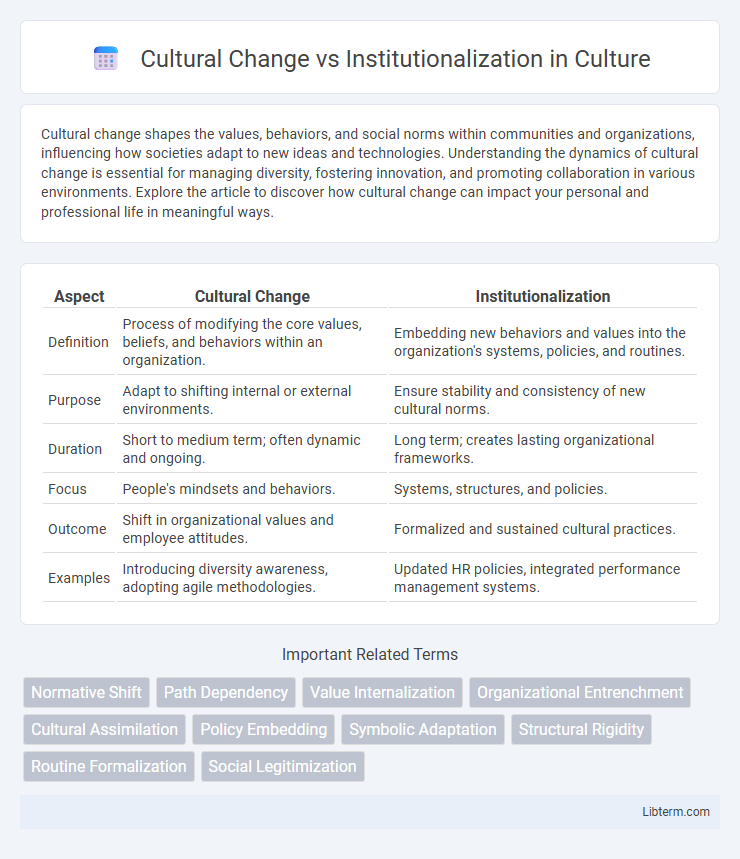Cultural change shapes the values, behaviors, and social norms within communities and organizations, influencing how societies adapt to new ideas and technologies. Understanding the dynamics of cultural change is essential for managing diversity, fostering innovation, and promoting collaboration in various environments. Explore the article to discover how cultural change can impact your personal and professional life in meaningful ways.
Table of Comparison
| Aspect | Cultural Change | Institutionalization |
|---|---|---|
| Definition | Process of modifying the core values, beliefs, and behaviors within an organization. | Embedding new behaviors and values into the organization's systems, policies, and routines. |
| Purpose | Adapt to shifting internal or external environments. | Ensure stability and consistency of new cultural norms. |
| Duration | Short to medium term; often dynamic and ongoing. | Long term; creates lasting organizational frameworks. |
| Focus | People's mindsets and behaviors. | Systems, structures, and policies. |
| Outcome | Shift in organizational values and employee attitudes. | Formalized and sustained cultural practices. |
| Examples | Introducing diversity awareness, adopting agile methodologies. | Updated HR policies, integrated performance management systems. |
Understanding Cultural Change: Definitions and Dynamics
Cultural change involves the transformation of shared values, beliefs, and practices within a social group, driven by internal innovation or external influences such as technology and globalization. Dynamics of cultural change include processes like diffusion, acculturation, and social movements that reshape cultural norms over time. Unlike institutionalization, which solidifies behaviors into formal structures and rules, cultural change remains fluid and adaptive, reflecting evolving societal needs and contexts.
What Is Institutionalization in Organizations?
Institutionalization in organizations refers to the process by which certain practices, norms, and values become embedded and standardized within the organizational structure and culture, ensuring consistency and stability over time. This phenomenon shapes employee behavior through formal rules, policies, and rituals, making the organizational environment predictable and resistant to rapid change. Unlike cultural change, which focuses on shifting mindsets and informal behaviors, institutionalization solidifies these changes into enduring frameworks that guide collective action.
Key Differences Between Cultural Change and Institutionalization
Cultural change involves shifts in shared values, beliefs, and behaviors within an organization, often driven by leadership vision or external forces, whereas institutionalization embeds these changes into formal structures, policies, and routines for long-term sustainability. Cultural change is typically dynamic and fluid, reflecting evolving social norms and employee attitudes, while institutionalization requires codification and reinforcement mechanisms that transform temporary shifts into permanent organizational practices. The key difference lies in flexibility versus permanence: cultural change adapts rapidly to environmental cues, whereas institutionalization solidifies these changes into the organization's foundational framework.
Drivers of Cultural Change: Internal and External Factors
Internal drivers of cultural change include leadership shifts, employee values evolution, and organizational restructuring that influence behaviors and norms. External factors comprise market dynamics, technological advancements, regulatory changes, and socio-economic trends that compel organizations to adapt their culture. Understanding the interplay between these internal and external drivers is crucial for successful institutionalization and sustainable cultural transformation.
The Role of Leadership in Shaping Culture and Institutions
Leadership plays a critical role in shaping organizational culture and driving institutionalization by setting values, behaviors, and norms that align with strategic goals. Effective leaders model desired practices, reinforcing cultural change through consistent communication and decision-making that embed these values into institutional policies and systems. Strong leadership commitment accelerates the transition from cultural change to sustainable institutionalization, ensuring long-term adaptation and resilience.
Resistance to Change: Barriers in Culture vs. Institutional Processes
Resistance to change often arises from deeply rooted cultural values and norms that shape employees' behaviors and attitudes, creating invisible barriers within an organization's social fabric. Institutionalization, by embedding practices and policies into formal structures, can reinforce these cultural barriers through standardized procedures and hierarchical controls. Overcoming resistance requires addressing both the emotional and psychological dimensions of cultural attachment alongside modifying institutional processes that perpetuate rigidity and inhibit adaptability.
Measuring the Impact: Evaluating Cultural Change vs. Institutionalization
Measuring the impact of cultural change involves assessing shifts in employee attitudes, values, and behaviors, often captured through surveys, interviews, and performance metrics. Institutionalization, however, requires evaluating the extent to which new cultural elements are embedded in organizational policies, procedures, and routines, indicating sustainable adoption. Effective evaluation combines qualitative insights with quantitative data to differentiate temporary cultural shifts from long-term institutionalized practices.
Case Studies: Successes and Failures in Cultural Transformation
Case studies in cultural transformation reveal that successful cultural change often hinges on strong leadership commitment and clear communication strategies that align organization values with employee behaviors, as demonstrated by companies like IBM and Nokia during their digital transitions. Failures frequently result from insufficient stakeholder engagement and rigid institutionalization processes that resist adaptation, illustrated by Kodak's inability to shift from a film-based culture to a digital mindset. Effective cultural transformation balances dynamic change initiatives with sustainable institutional practices to embed new values and behaviors long-term.
Strategies for Balancing Cultural Change and Institutional Stability
Effective strategies for balancing cultural change and institutional stability involve integrating adaptive leadership practices that promote innovation while preserving core organizational values. Implementing continuous feedback mechanisms and change management frameworks helps embed new cultural elements without disrupting established processes. Aligning cultural initiatives with institutional goals ensures sustainable transformation and long-term resilience.
Future Trends: The Evolving Relationship Between Culture and Institutions
Future trends indicate a dynamic evolution in the relationship between cultural change and institutionalization, driven by digital transformation and globalization. Institutions increasingly integrate adaptive cultural practices to foster innovation, resilience, and inclusivity in diverse environments. Emerging technologies and shifting societal values accelerate the institutionalization of culture, reshaping organizational norms and governance frameworks.
Cultural Change Infographic

 libterm.com
libterm.com